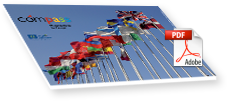How to read a “Competence-Radar“?
Prior to and at the end of a work placement abroad, the mobility participants give – within the scope of a competence description - a self-assessment of their skills and the development of their personal competence profiles. This competence profile is shown in the COMPASS Database in the form of two “Competence Radars“ each comprising six competence categories.
In line with the COMPASS Competence Chart, the competence description includes 4 fields: language skills, professional skills, interpersonal and personal skills. On a scale (0-6), the participants can assess the degree of their individual “Can Descriptions:
|
Assessment |
Knowledge/Experience |
|
0 |
I don’t know, I have never tried |
|
1 |
Trained in it, but have never tried |
|
2 |
I have done this before, a little experience |
|
3 |
Trained in it, but only little experience |
|
4 |
Quite good at it, some experience |
|
5 |
Good at it, experienced |
|
6 |
Specialising in it, in-depth experience |
The COMPASS Database refers to these assessments to establish a mean value for each competence category which, in the respective Competence Radar is shown as a line. Thus, the Competence Radars give a first overview of the fields of strengths and weaknesses as described by the mobility participants. However, the don not reflect the actual competence level: some mobility participants tend to underrate their own skills. Others overrate them in order not to put their opportunities regarding a work placement at risk.
Therefore, the self-assessment should be specified, completed or, if need be, corrected within the scope of the counselling or selection interview. Since the COMPASS Method is designed to visualise competence gains, the competence profile prepared prior to the stay abroad should be as realistic as possible; if the initial assessment is too high, the competence gains can hardly be made visible.
The assessment of Can Descriptions within the scope of the second competence description made at the end of the stay abroad, should – because of the experience made abroad – lead to better results. In the Competence Radar the results are shown as a second line which, ideally, should be above the first line, so that the individual competence gain fore ach competence category is visible. As, however, this does allow any conclusion to the context in which the competence gains were achieved, they should be specified in the description of the learning achievements in the E-portfolio.
The allocation of learning achievements to the levels of the COMPASS Competence Chart depends on the format of the competence description:
A selection from all Can Descriptions in the COMPASS Competence Chart allows an assessment of the competence levels of applicants whose initial levels or work experience are not precisely known. Based on the results established with the help of the competence description, the learning objectives can then be discussed for each level and the subsequent competence description can be specified.
A target-group- or occupation-related specialisation of the competence description (lowering of levels, completion by Can Descriptions relating to the occupational field) facilitates the allocation of results to the levels laid down in the Competence Chart.
Whether mobility participants have the competence levels that are required for a qualification-related assessment of their learning achievements will have to be agreed by the participants, the sending and hosting organisations in an in-depth dialogue.









